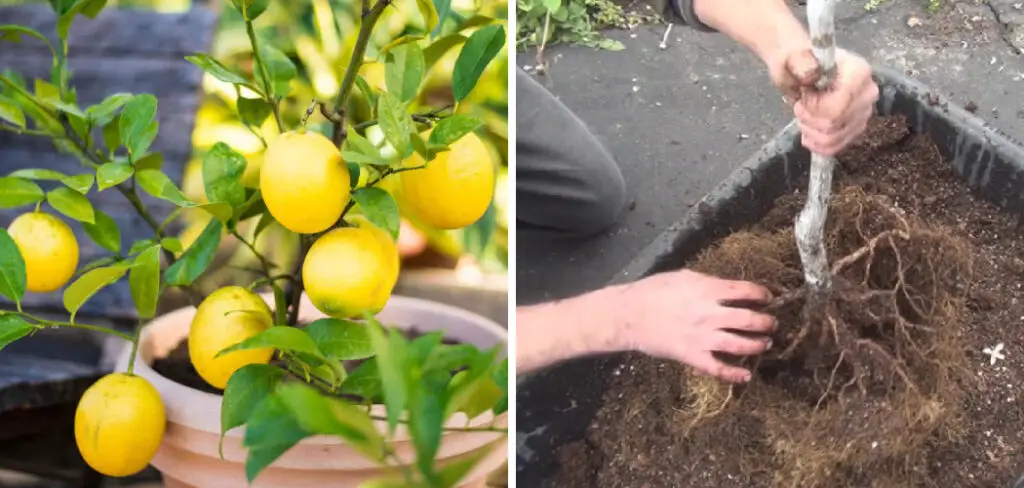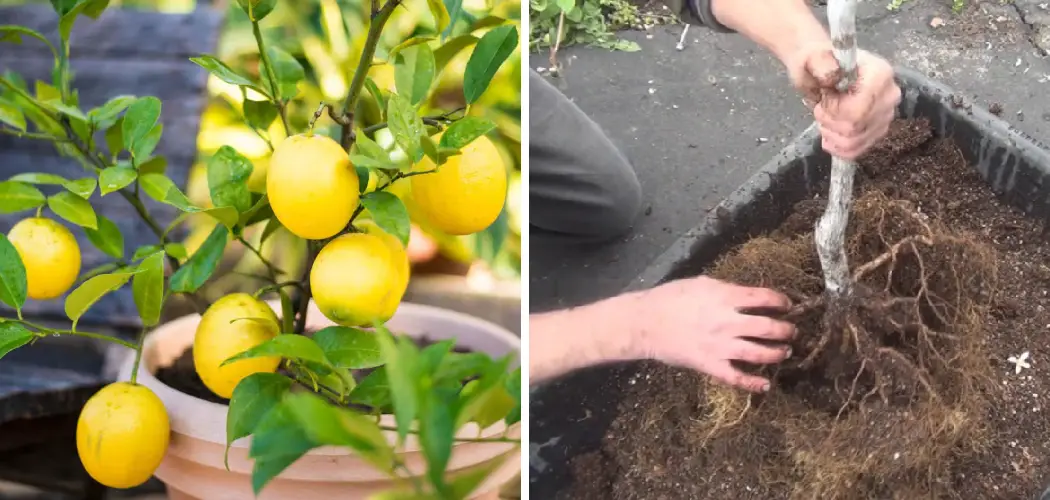Repotting a lemon tree is essential for maintaining its health and promoting robust growth. As lemon trees grow, their roots expand and require more space and fresh nutrients to support their development. Repotting your lemon tree ensures it has access to fresh soil, which replenishes essential nutrients that might have been depleted over time.

Additionally, the new pot provides more space for the roots to spread out and grow, which can prevent root binding and waterlogging issues. Knowing how to repot a lemon tree correctly can make a significant difference in the tree’s health and fruit production. The process involves selecting the right pot and soil, carefully removing the tree from its old pot, and ensuring proper aftercare. By following these steps, you can help your lemon tree thrive and enjoy bountiful harvests for years to come.
Understanding When to Repot a Lemon Tree
Signs It’s Time to Repot
Recognizing when to repot your lemon tree is crucial for its continued health and growth. Some common indicators that it’s time to repot include roots growing out of the drainage holes, soil that dries out very quickly after watering, and stunted growth despite regular care and feeding.
These signs suggest that the tree has outgrown its current pot and is in need of more space. The ideal time to repot a lemon tree is in early spring, just before new growth starts. This timing allows the tree to establish itself in its new pot before the active growing season begins.
Choosing the Right Time
The best seasons for repotting a lemon tree are spring or early summer when the tree is beginning its active growth phase. Repotting during these times ensures that the tree has the entire growing season to establish itself in the new pot.
It’s important to avoid repotting during periods of extreme temperatures, whether very hot or very cold, as this can cause additional stress to the tree. Choosing mild weather conditions will help the tree transition smoothly to its new environment without experiencing transplant shock. Proper timing is key to ensuring the successful repotting and future growth of your lemon tree.
How to Repot a Lemon Tree: Steps to Repotting a Lemon Tree
1.Preparing the Tree
Proper preparation of your lemon tree before repotting is crucial to ensure a smooth transition and promote healthy growth. Start by watering the lemon tree a day before you plan to repot. This will help to soften the soil, making it easier to remove the tree from its current pot without causing unnecessary stress on the roots.

Once the soil is adequately moistened, gently begin to loosen the root ball by pressing the sides of the pot. Using your fingers, gently work around the root ball to remove excess soil. This process will help free the roots and ensure they are ready for the new pot. Be thorough but gentle to avoid damaging the delicate root system. Proper preparation will set the stage for a successful repotting process and reduce the chances of transplant shock.
2.Removing the Tree from the Old Pot
Carefully extracting the lemon tree from its old pot is the next important step. Start by laying the pot on its side and gently tapping the bottom and sides to loosen the root ball. Using one hand to support the base of the tree and the other to slowly slide the root ball out of the pot can minimize the risk of damage. If the tree is still stuck, you may need to run a thin tool, like a butter knife, around the inner edge of the pot to further loosen the roots. Once the tree is free, inspect the root system thoroughly.
Look for any roots that are damaged, excessively long, or appear to be circling tightly (root-bound). Trim these roots with clean, sharp scissors or pruning shears, taking care not to remove more than a third of the root mass. This step is crucial for promoting healthy new root growth in the new pot.
3.Planting in the New Pot
Now that your lemon tree is ready for its new home, begin by adding a layer of fresh potting mix at the bottom of the new pot. This base layer should be thick enough to provide a cushion for the roots and facilitate proper drainage. Position the tree in the center of the new pot, ensuring that it sits at the same depth as it did in the old pot. Holding the tree steady, carefully fill around the roots with the potting mix, gently pressing it down to eliminate air pockets.

Continue adding soil until the pot is almost full, leaving about an inch of space at the top for watering. Make sure the tree is upright and stable before giving it a thorough watering. This helps to settle the soil around the roots and starts the tree off on the right foot in its new environment. Proper planting techniques are essential for the tree’s adaptation and future growth.
Aftercare Post-Repotting
Proper aftercare is essential to ensure your lemon tree adjusts well to its new pot and continues to thrive. This involves establishing a consistent watering schedule, appropriate fertilization, and maintaining the right light and temperature conditions.
Watering
A consistent watering schedule is crucial for the health of a newly repotted lemon tree. Allow the top inch of soil to dry out between waterings to prevent overwatering, which can lead to root rot.
Deep watering is important as it encourages the roots to grow deeper into the soil, resulting in a robust root system. To deep water, water the tree thoroughly until the water drains out from the bottom of the pot. This ensures that the entire root mass receives adequate moisture without waterlogging the soil.
Fertilizing
Using a balanced, slow-release citrus fertilizer supports the tree’s recovery and promotes healthy growth. Fertilize newly repotted lemon trees by incorporating the fertilizer into the top layer of the soil according to the product’s instructions.
Generally, slow-release fertilizers only need to be applied every 3-6 months, depending on the formulation. Be cautious not to over-fertilize, as this can harm the tree. Consistent, but restrained fertilization helps establish the tree in its new environment by providing a steady supply of essential nutrients.
Providing Proper Light and Temperature
Ensuring your lemon tree gets plenty of bright, indirect sunlight is key for its health and fruit production. Place the tree near a window where it can receive at least 8 hours of light per day.
Additionally, maintain optimal temperature conditions, ideally between 60-70°F, for indoor lemon trees. Avoid exposing the tree to sudden temperature changes or drafts, which can cause stress. Proper light and temperature conditions will help your lemon tree adapt smoothly to its new pot and encourage vigorous growth.

Monitoring and Maintenance
Maintaining a close watch on your lemon tree after repotting is crucial for its ongoing health and productivity. Regular inspections and proper pruning help ensure that the tree remains strong and resilient against potential threats.
Regular Inspections
Frequently inspecting your lemon tree allows you to catch signs of stress, pests, or disease early. Look for yellowing leaves, wilting, or any unusual spots that might indicate problems. Pests such as aphids, spider mites, and scale insects can be detected by closely examining the leaves and stems. Early detection of these issues is vital, as it enables timely intervention, which can prevent severe damage to the tree.
Use organic or chemical treatments as needed to address any pest problems, and adjust care practices to correct any signs of stress, such as adjusting watering habits or improving light exposure.
Pruning and Trimming
Pruning is an essential aspect of lemon tree maintenance, helping reduce plant stress and encouraging healthy new growth. Begin by removing any damaged or dead branches with clean, sharp pruning tools. This not only tidies the tree but also prevents pests and diseases from taking hold in weakened areas.
Additionally, selectively prune overcrowded sections to improve air circulation and light penetration, which fosters a healthier growing environment. By focusing on the tree’s overall shape and structure, you can guide its growth and enhance its fruit production potential. Regular pruning ensures that your lemon tree remains vigorous and productive year-round.
Troubleshooting Common Issues
Even with proper care, your lemon tree may encounter issues post-repotting. Common problems include transplant shock, root-related issues, pest infestations, and nutrient deficiencies. Addressing these promptly ensures the tree’s ongoing health and productivity.
Dealing with Transplant Shock
Lemon trees can exhibit symptoms of transplant shock such as wilting and yellowing leaves. This shock occurs due to the disturbance of the root system. To minimize transplant shock, maintain a consistent watering schedule to keep the soil moist but not waterlogged.
Providing temporary shade helps shield the tree from excessive sunlight, reducing stress. Gradually reintroduce the tree to full sunlight over a week or two. Ensuring the tree’s environment remains stable and supportive helps it adjust more quickly to its new pot.

Addressing Root Problemss
Root issues, such as rot or binding, can severely impact the health of your lemon tree. Signs of root rot include a foul smell, mushy roots, and yellowing leaves. To treat root rot, remove the affected roots and replant in well-draining soil.
Avoid overwatering to prevent future occurrences. Root binding, indicated by roots circling the pot, restricts growth. Prune excessive roots and ensure the new pot offers ample space. Using pots with drainage holes and ensuring proper watering techniques are key to maintaining a healthy root system, promoting overall tree health and growth.
Special Considerations for Indoor vs. Outdoor Lemon Trees
Indoor Lemon Trees
Managing an indoor lemon tree requires attention to humidity and light levels. Indoor air can be dry, especially during winter months, so using a humidifier or placing a tray of water near the tree can help maintain appropriate humidity levels.
Ensure the tree receives plenty of bright light by keeping it near a south-facing window. If natural light is insufficient, supplement with grow lights to provide at least 8 hours of light daily, promoting healthy growth.
Outdoor Lemon Trees
For outdoor lemon trees, selecting pots that can endure temperature fluctuations is crucial. Materials like terracotta or resin can better withstand varying conditions.
During colder months, protect your tree by mulching around the base to retain warmth and using frost clothes or blankets to cover the tree during frosty nights. Additionally, consider moving potted trees closer to a building for added protection from the cold and wind, ensuring the tree remains healthy year-round.

Conclusion
By following these key steps on how to repot a lemon tree, you can ensure its successful transition and ongoing health. Proper preparation, including selecting the right soil and pot, sets the foundation for your tree’s future growth.
Aftercare, such as consistent watering, light management, and regular inspections, fortifies this foundation, helping the tree adapt and thrive in its new environment. Regular pruning and addressing common issues as they arise will further support a vigorous, productive lemon tree. Adhering to these practices ensures your lemon tree remains healthy and fruitful for years to come.
About
Outdoor Fixes is a distinguished figure in the world of Diy design, with a decade of expertise creating innovative and sustainable Diy solutions.
His professional focus lies in merging traditional craftsmanship with modern manufacturing techniques,
fostering designs that are both practical and environmentally conscious. As the author of diy,
outdoorfixes delves into the art and science of outdoorfixes-making, inspiring artisans and industry professionals alike.
Education RMIT University
(Melbourne, Australia) Associate Degree in Design (Outdoor Fixes) Focus on sustainable design, industry-driven projects,
and practical craftsmanship. Gained hands-on experience with traditional and digital manufacturing tools, such as CAD and CNC software.
Nottingham Trent University
(United Kingdom) Bachelor’s in outdoorfixes.com and Product Design (Honors) Specialized in product design with a focus on blending creativity with production
techniques. Participated in industry projects, working with companies like John Lewis and Vitsoe to gain real-world insights.
Publications and Impact
In diy, Outdoor Fixes his insights on indoor design processes, materials, and strategies for efficient production.
His writing bridges the gap between artisan knowledge and modern industry needs, making it a must-read for both budding designers and seasoned professionals.

